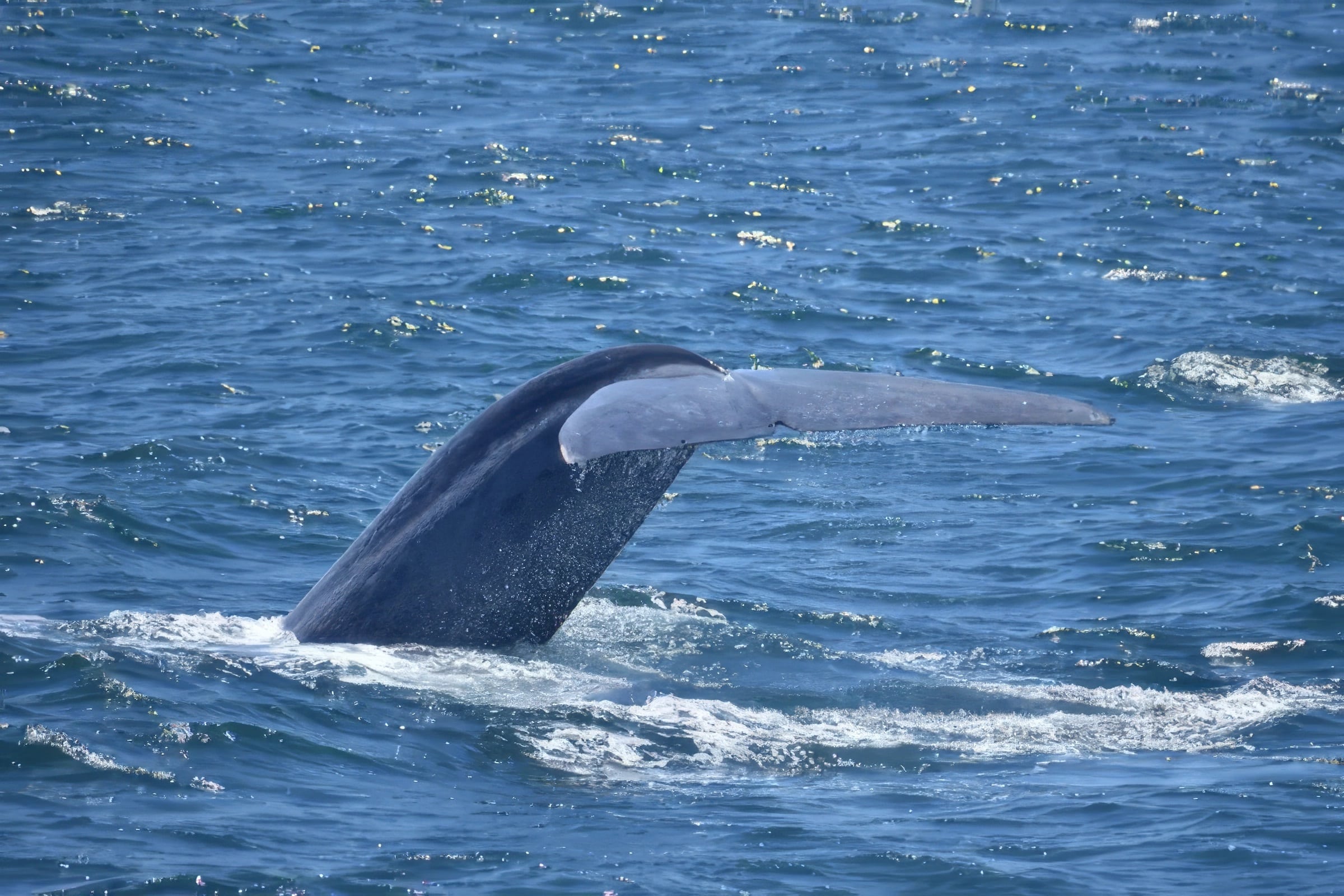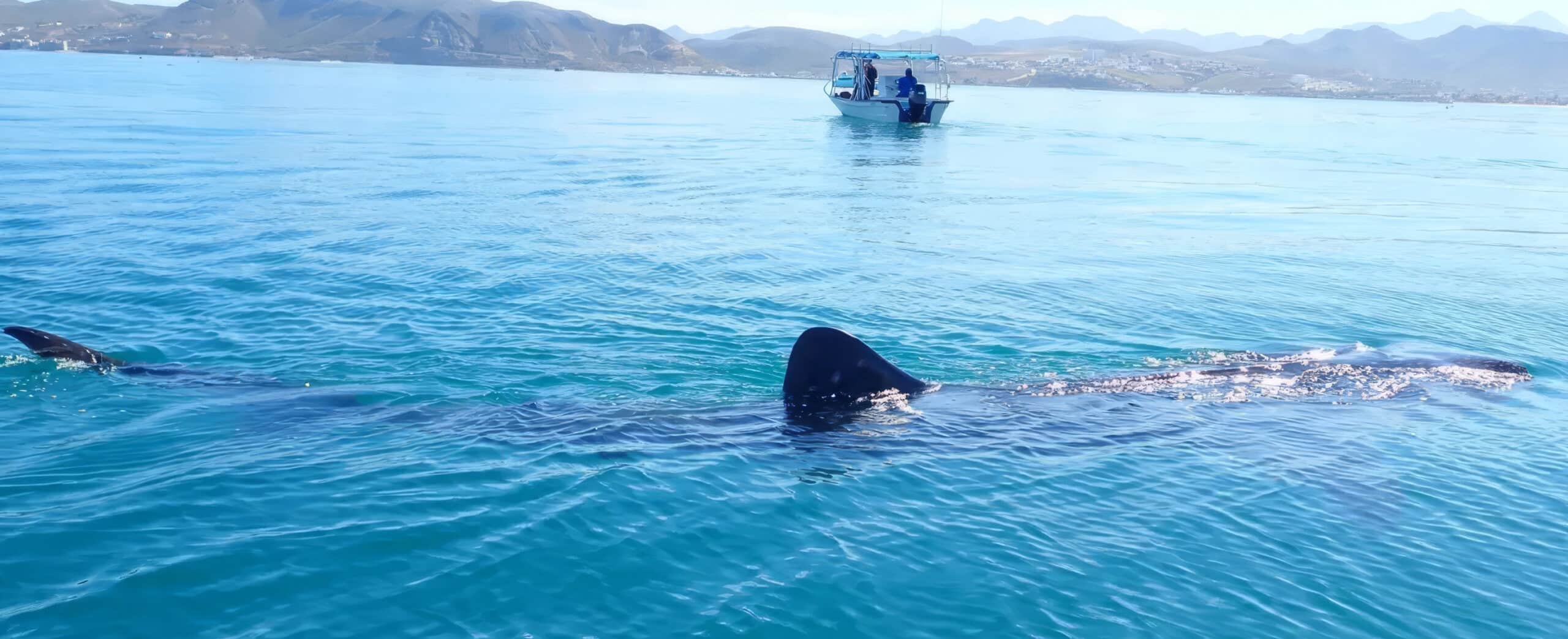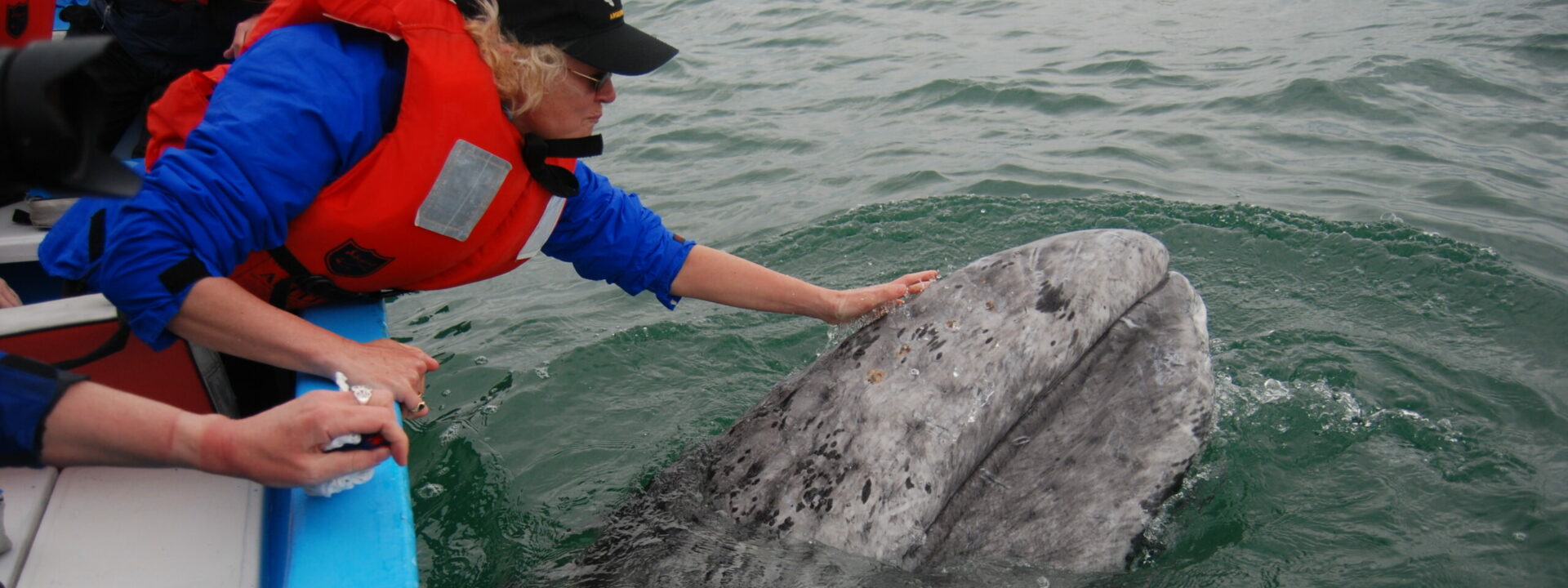Baja California and the Sea of Cortez
Whales, Dolphins, Seals and Seabirds Monday 24th March – Friday 4th April 2025
Exploring the “Mexican Galapagos”, an area with one of the greatest diversities of marine mammals on Earth
The waters surrounding the Baja California Peninsula off the Pacific coast of Mexico are widely considered to be amongst the best in the world for marine mammals and on this exceptional trip we will travel south from San Diego with the expectation of some truly life changing encounters with an array of whales and dolphins.
For many previous participants, the highlight has been the two days in the San Ignacio Lagoon where female Grey Whales and their calves gather. Here, there are opportunities for some incredible interactions with these “friendly” cetaceans as they often swim up to the boats waiting and expecting visitors to pat them. Making eye contact with these 12 metre long gentle giants is something you will never forget !!
There is, however, much more to this trip and over the twelve days of this expedition cruise on Spirit of Adventure, there will also be chances to look for Blue, Fin, Humpback, Bryde’s, Minke, Sperm and Short-finned Pilot Whales, along with Pacific White-sided Dolphin, Bottlenose Dolphin, Short-beaked and Long-beaked Common Dolphins, as well as chances for rarer species such as Peruvian Beaked Whale and Dwarf Sperm Whale.
An excellent range of seabirds are also likely with Laysan and Black-footed Albatrosses, Guadalupe, Scripp’s Murrelets and Craveri’s Murrelets, Cassin’s Auklet, Black-vented Shearwater, Black and Least Storm-Petrels all possible, along with breeding boobies, frigatebirds and tropicbirds.
For those keen on landbirds, there will also be an opportunity to look for a wide range of species including a number which are endemic to the peninsula including Xantus’s Hummingbird and Grey Thrasher.
Tour Highlights
- Experience some of the best whale watching anywhere on Earth with amazing opportunities for close encounters with Grey Whales
- Good chances of seeing Blue, Fin, Humpback, Bryde’s, Minke and Sperm Whales plus multiple species of dolphins including Pacific White-sided and Risso’s and rarer cetaceans such as Peruvian Beaked Whale and Dwarf Sperm Whale
- Look for Northern Elephant and Guadalupe Fur Seals, as well as California Seal Lions, Whale Sharks, turtles, manta rays and much more
- A great range of potential seabirds including Laysan and Black-footed Albatrosses, Guadalupe, Scripp’s Murrelets and Craveri’s Murrelets, Cassin’s Auklet, Black and Least Storm Petrels, Heermann’s, California and Yellow-footed Gulls as well as boobies, frigatebirds and tropicbirds
- Explore remote islands, beautiful turquoise water beaches and coastal mangroves
- Whilst ashore, join birding excursions to look for specialities such as Xantus’s Hummingbird, Grey Thrasher, Gila Woodpecker and Cactus Wren
Outline Itinerary
-
Board Searcher by 20:00 and sail at approximately 22:00. Eleven nights aboard Searcher.
-
Brief stop in Ensenada, Mexico to clear Immigration and Customs. Head offshore in search of cetaceans and seabirds.
-
Landing on San Benitos Island with the option to visit rookeries of Northern Elephant and Guadalupe Fur Seals.
-
Arrive San Ignacio Lagoon where we have two days with the “friendly” Grey Whales. Enjoy great views from local pangas. Explore ashore and in mangrove channels.
-
Offshore from Magdalena Bay looking for oceanic wildlife with chances for Blue and Humpback Whales as well as dolphins, turtles and pelagic seabirds.
-
Round the southern tip of the Baja California Peninsula and visit the Gorda Banks where there can be fantastic whale watching.
-
A flexible itinerary to maximise on wildlife opportunities and experiences with whale watching, visits to islands, islets and remote beaches and snorkelling.
-
Disembark Searcher after breakfast in Cabo San Lucas.

Located on the Pacific coast of Mexico, Baja California is one of the world’s longest peninsulas and this island-studded marine wilderness boasts one of the greatest diversities of sea life on Earth.
It is a truly outstanding area for whales and dolphins with the waters providing rich feeding grounds for Blue, Fin, Humpback, Grey, Bryde’s, Minke, Sperm and Short-finned Pilot Whales. We also expect to see Pacific White-sided Dolphins, Bottlenose Dolphins (both inshore and offshore forms), plus Short-beaked and Long-beaked Common Dolphins, with the chance for rarer species such as Peruvian Beaked Whale and Dwarf Sperm Whale.
The vessel is sometimes surrounded by pods of dolphins numbering well over a thousand individuals, bubbling out of the sea in every direction, with small groups venturing in to bow ride. On previous trips, we have also enjoyed bow riding Orcas, lunge feeding Blue Whales and groups of up to twenty Sperm Whales.
For many people, however, the biggest draw is the Grey Whales as the females and their newly born calves will be in San Ignacio Lagoon at the time of our tour and we will venture into the bay in local ‘pangas’ (small boats with experienced local drivers) to see them. San Ignacio’s Grey Whales are world-renowned for being “friendly” and will often nudge the side of the pangas, frequently lying alongside waiting to be rubbed by your hands with their mouths open displaying huge curtains of creamy white baleen plates. Eye-to-eye contact with these amazing animals is something you will never forget!!
We spend two days at this special place but there is much more to this amazing wildlife holiday which will travel the entire length of the Baja California Peninsula stopping at remote offshore islands for nature walks, birdwatching and visits to rookeries of Guadalupe Fur and Northern Elephant Seals.
There will be time in the deeper waters where we hope to find species such as Baird’s, Cuvier’s and Peruvian Beaked Whales before we round the southern tip of the peninsula to conclude with four days exploring the wildlife-rich Sea of Cortez/Gulf of California.
This is the youngest and perhaps the richest sea in the world with nutrients from deep submarine canyons providing food for an abundance of fish and plankton. We will spend the remainder of the expedition cruising these tropical waters looking for cetaceans, birds and other wildlife and exploring a number of fascinating islands.
On previous visits, there have been numerous encounters with feeding Humpback Whales and we are likely to see incredible displays of breaching, flipper slapping and lobtailing.
There are also over 600 species of fish, including huge Manta Rays and several species of shark with the chance for great views of both Blue and Hammerhead Sharks, as well as turtles, Sailfish and huge Sunfish.
At night we may marvel at bioluminescent seas and watch seahorses, sea snakes and flying fish as they are drawn to the ship’s lights and if you are really lucky, bioluminescent dolphins!
In recent years, it has also been possible to find the Whale Sharks that visit this region and there may be opportunities to swim with these enormous fish.
The trip will, of course, also be a fantastic opportunity to see a great range of seabirds and localised landbirds. Both Guadalupe and Scripp’s Murrelets (formally known collectively as Xantus’s Murrelet but split in 2012) are possible plus Craveri’s Murrelet, Black-vented Shearwater, Black and Least Storm-Petrels and both Laysan and Black-footed Albatrosses.
Large numbers of tropical seabirds breed in the area and those we are likely to see include Blue-footed Boobies, Magnificent Frigatebirds and Red-billed Tropicbirds, whilst ashore there are opportunities to look for a great range of species including the highly localised Xantus’s Hummingbird and Grey Thrasher, both of which are endemic to the peninsula.
On some islands, we may see giant cacti such as the Cardon which can reach a height of over 65 feet (20 metres) and tower over a host of curiously shaped succulents. This is the territory of bird species such as Cactus Wren, Grey Thrasher and Gila Woodpecker, as well as many other specialised desert inhabitants including various lizards and the endemic Rattleless Rattlesnake, which is harmless.
Travelling from temperate to tropical waters makes this an extraordinarily rich and varied expedition and the days are packed with superb whale and dolphin watching, shore walks to investigate forests of cacti, tide pools and mangroves, some excellent bird watching, and snorkelling with colourful fish and inquisitive California Sea Lions.
The excellent crew and guides aboard Searcher will ensure you have an amazing experience and “mind blowing”, “brilliant”, “fantastic” and “best wildlife encounters I have ever had anywhere in the world” are just a few examples of the post-trip comments we have received from previous clients.

Day 1: Board Searcher and sail
The day is at leisure in San Diego with boarding of Searcher starting at 19:00.
There will be an introduction to the ship, crew, naturalists and a safety drill before the vessel sails at approximately 22:00. Eleven nights aboard Searcher
Day 2: Mexican clearance and offshore wildlife viewing
The day will start with a brief stop in Ensenada, Mexico where we clear Immigration and Customs. We will then head offshore in search of cetaceans and seabirds and the possibilities could include both Long-beaked and Short-beaked Common Dolphins.
We may also find our first Grey Whales and there will undoubtedly be plenty of seabirds to enjoy with the possibilities including Black-vented Shearwater, Pink-footed Shearwater, Sooty Shearwater, Masked Booby, Royal Tern and Bonaparte’s Gull.
Day 3: Morning on San Benitos Island. Afternoon at sea
We will start the day exploring the San Benitos Islands which are an important location for Northern Elephant Seals. From December to March, all suitable beaches on West San Benitos Island are occupied by breeding seals, with the season initially starting with mothers nursing their pups.
California Sea Lions and threatened Guadalupe Fur Seals are also often seen and there will be nature walks ashore which provide opportunities for close looks at hundreds of these fascinating animals.
This archipelago has been isolated from the mainland for tens of thousands of years and, as a result, has a number of endemic plants including San Benito Tarweed which grows profusely in many areas.
We are likely to land on the largest island, Benito del Oeste, and investigate its unique ecosystem, and for those who wish, there will be a walk to the island’s lighthouse.
The island is covered in seabird burrows with many of these being Cassin’s Auklets and both Scripp’s and Guadalupe Murrelets. We are unlikely to see these species ashore, however, as they only transit between the sea and their burrows after dark (to avoid predators), although we may witness the danger of doing this, as some birds occasionally crash into the large cacti and becoming impaled on the thorns. We will also hope to see the ‘San Benitos Sparrow” which is sometimes regarded as an endemic species rather than a subspecies of Savannah Sparrow.
Searcher is one of the few vessels which has permits to undertake this fantastic voyage © Team Searcher
There is likely to also be the option to explore the scenic coast using Searcher’s skiffs which is an opportunity to photograph the sea lions which can be extremely curious.
We then plan to spend the afternoon at sea looking for cetaceans and seabirds with Blue Whale being one of the species we could see. Indeed, on our 2019 voyage, we spent over an hour with one of these huge cetaceans.
This area can also be good for Cassin’s Auklet with over one hundred individuals seen during the afternoon on one of our recent tours along with other possibilities such as Black-footed Albatross.
Days 4-5: San Ignacio Lagoon
We will arrive at San Ignacio Lagoon where we have two days to enjoy the “friendly” Grey Whales. Searcher will be anchored in the lagoon and there will be the opportunity to make several trips in local ‘pangas’ (small boats with experienced local drivers) to see the whales.
The females and calves will often come right up to us and nudge the side of the pangas and making eye contact with these 12m long cetaceans is an incredible and often very moving experience. There may well be opportunities to even gently scratch the whales’ heads, as they will often float alongside the boats almost demanding us to interact with them.
Day 6: Offshore from Magdalena Bay
We plan to spend the day at sea offshore from Magdalena Bay. This area is a prime location for cetaceans with chances for Blue, Fin, Bryde’s and Humpback Whales and a range of other cetaceans.
On occasions, the ‘Blues’ which are the biggest animal that has ever lived on our planet, can be extremely close to the vessel resulting in some simple stunning views. Indeed, a wide angle lens was needed in 2019 when a mother and calf swam right under the bow of the boat !!
We can expect to see other marine species with large pods of Long-beaked Common Dolphins a definite possibility along with turtles such as Loggerhead.
A variety of seabirds are also possible including Black Storm Petrel, Red-billed Tropicbird and both Royal and Elegant Terns, with a Nazca Booby seen on one of our recent visits.
Day 7: Entering the Sea of Cortez
We will round the southern tip of the Baja California Peninsula, passing the small town of Cabo San Lucas and are likely to spend the afternoon exploring the Gorda Banks.
Once again, there are some great opportunities for whale watching with this area often being especially good for Humpback Whales which gather here. Our skilful skipper will aim to carefully approach them and we have previously enjoyed some exceptional views off the bow of our ship.
Later in the day, we may make a landing where options could include snorkelling or going on a bird walk. Fish which have been seen here previously include Angelfish, Rainbow Wrasse and Spotted Eagle Ray, whilst the birds could include Crested Caracara, Cactus Wren, Gila Woodpecker, California Gnatcatcher, Pyrrhuloxia and both Scott’s and Hooded Orioles.
Days 8-11: Exploring the Sea of Cortez
We have four days to explore the Sea of Cortez and the programme will deliberately be kept flexible to maximise on the overall experience. There is likely to be a mix of watching marine wildlife from Searcher, going ashore for land-based exploration and birdwatching, and potentially further use of local pangas.
In recent years, the number of Whale Sharks which gather in the region has increased markedly as these huge fish are now protected and there can sometimes be as many as one hundred individuals which migrate here to feed on the rich plankton soup. If the ship’s team know that where these are present, there is likely to be an opportunity to swim with them which can be an extremely memorable experience. (Please note there may be an additional charge payable locally for pangas).
Previous trips have also enjoyed multiple encounters with Blue Whales and occasionally these have even been seen lunge feeding close to the boat. Fin and Humpback Whale are also possible, and we are likely to see various dolphin species as well as rays.
There will also chances to go ashore and enjoy the extraordinary landscapes, plants (including some huge cacti) and birds and to snorkel with tropical reef fish.
Day 12: Disembark in Cabo San Lucas
Our expedition will end after breakfast in Cabo San Lucas.

THE SHIP
We have previously used Spirit of Adventure for our Baja and Sea of Cortez voyages, but this vessel is now no longer operating whale watching trips. We are, therefore, now using Searcher which we chartered some years ago for our highly successful “Mexican Pelagic” voyage. The team on Searcher are highly experienced and have been operating whale watching trips in this region for many years and we believe this is a perfect replacement for Spirit of Adventure.
Searcher is an 95-foot long, air-conditioned, U.S registered vessel. Most of the cabins are twin (possible triple on request) cabins with almost all having upper and lower berths. Washbasin (filtered water) and bedside reading lights. Cabins are small (for sleeping and changing), with only limited storage space, however, for viewing wildlife, the boat is an ideal option.
There are four toilets, two hot freshwater showers and a spacious salon for relaxing, socialising and eating. The vessel has 3 metal-hulled skiffs. All meals and beverages aboard Searcher include beer, wine or soft drinks.
Sturdy Mexican pangas operated by local fishermen are used for close encounters with the Grey Whales in San Ignacio Lagoon, with the Searcher’s skiffs used at all other times.
CABIN OPTIONS AND PRICES
Twin Cabin – £5,695 per person
Deposit: £1,425 (twin cabin per person)
Cost includes
- Accommodation, meals and most beverages aboard Searcher from breakfast on day 2 through to breakfast on day 12
- Panga rides in the San Ignacio Lagoon
- Mexican tourist card, permits and fees
- All shore excursions
- Services of Searcher’s naturalist team
- WildWings/Limosa checklist of birds and mammals and pre-tour information pack
Cost excludes
Flights, visa fees, insurance, drinks, airport meals/snacks, any hotels or meals ashore before or after the cruise (ie in San Diego or Cabo San Lucas), transfers at beginning and end of the cruise (although it is only a 10 minute walk from our recommended hotel in San Diego to the wharf), crew gratuities, panga driver gratuities, fees and cost of pangas for swimming with Whale Sharks, laundry and other items of a personal nature.
Ask About This Tour
If you have any questions about this tour, please enter your details here and we will get back to you as soon as possible.
Alternatively, contact us by email or phone. We look forward to hearing from you!
- 0117 965 8333
- [email protected]
Or complete the contact form and we will endeavour to get back to you as soon as possible.
* = required field


